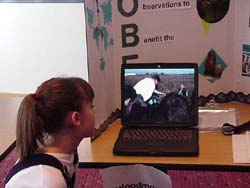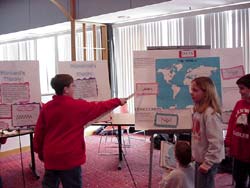Stars and STEM Stories
Partnerships Strengthen GLOBE Schools
Bowling Green University, a GLOBE Partner, works closely with Woodmore Elementary (Woodville, OH), Kenwood Elementary (Bowling Green, OH), and Perryburg High School (Perrysburg, OH) to increase the impact of the Program.

"We, like GLOBE, have a partnership approach and we're finding that we draw on each other's strengths," said Dr. Jodi J. Haney, associate professor of education at Bowling Green and GLOBE's partnership coordinator. Bowling Green's partnership also includes pre-service teachers at the college level.
Haney and the newly trained GLOBE teachers at the three schools gathered for a "GLOBE Colloquium" to introduce the Program to an audience of peers, parents, school administrators and university scientists and educators. GLOBE students and teachers demonstrated to the community the potential of the GLOBE protocols they mastered.
"The colloquium has a special impact because we had fifth graders and college students in the same room, and the university students were amazed by what the younger children could do," Haney said.
The fifth and sixth graders at Woodmore, for example, gave a computer multimedia demonstration of their GLOBE work. As part of their overall presentation, students showed fourth graders how GLOBE measurements could aid them in their weather unit. Already, Woodmore teachers are planning to expand their GLOBE involvement to include more age levels and more protocols, according to fifth-grade GLOBE teacher Beverly Pittman. "We are trying to establish credibility with the GLOBE scientists by carefully gathering and reporting atmosphere data," Pittman said. "Then we will add hydrology protocols, and we are interested in studying fog days next fall."

At Kenwood Elementary, fourth-grade students challenged the "Distance Theory." That theory holds that because the Earth's elliptic orbit varies the planet's distance from the sun, it creates seasons of varying warmth. However, GLOBE students Marcus Gonder, Jon Heider, David Powell, Kylie Robinson, Rachel Snyder, and Nate Terry argued that if the Distance Theory were correct, then the entire Earth would experience warm and cold seasons at the same time.
The Tilt Theory states that as the Earth moves around its orbit on a tilted axis, sunlight strikes the northern and southern hemispheres at different angles. This changes the amount of heat reaching the two hemispheres over the year, with the equatorial region maintaining a relatively constant temperature.
GLOBE data from northern, southern, and equatorial schools support the Tilt Theory, the students concluded. The children looked up data from schools in Australia, Benin, Suriname, Finland and Japan, and graphed and analyzed it themselves. As Kenwood GLOBE teacher Lane Hakel noted, most adults go through life believing in the Distance Theory, despite strong evidence to the contrary. He and Dr. Stephen Van Hook, a scientist at Bowling Green State University who works with Kenwood students, are submitting their students' work to the GLOBE site as a student investigation and are writing an article for a science education journal.
"I think science education is very important at the elementary and middle school levels because, by college, people can often have a negative attitude," said Dr. Van Hook. "These people will be our college students of the future. One of the things I like about GLOBE is that it's the first program I've seen with real justification to having computers hooked up to the Internet in school. They really use it in a serious way."
Hakel, who is using GLOBE protocols to teach fourth, fifth and sixth grades, agreed. "I really like how the kids seem to understand that what they're doing is making a difference," he added. "Empowering kids that are nine and ten years old in that way is really powerful."
Carrie Rathsack, a GLOBE teacher at Perrysburg High School, reports that students there have formed a GLOBE club. The students want to use GLOBE protocols for advanced projects. Among their proposals is to begin an environmental class, to use visualizations in various projects, and to instruct younger students at the junior-high and elementary school levels in GLOBE-related activities.
Finally, Haney's own students used GLOBE in their science-education curriculum studies, as part of their "Problem-Based Learning Strategies." Using GLOBE protocols and learning activities, students generated a "driving question of interest", developed a research plan, conducted tests, recorded results, analyzed the data, and presented their findings.
"We believe this is an excellent model, having these different schools, with different levels, including the university," said Bowling Green's Haney. "Elementary and secondary teachers can share and collaborate to each other's benefit, and we've seen that taking place."
22 August 2001





